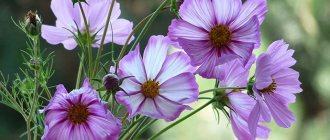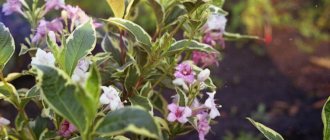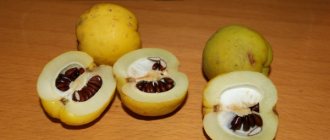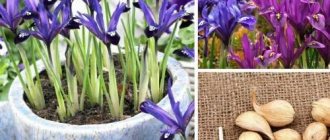- November 3, 2018
- Flowers
- Irina Tsirikhova
One can have different attitudes towards traditions and legends, but scientists have long noticed that grains of information contained in ancient legends and customs are an encrypted message. And it depends on us: will we solve this code or pass by. As for chrysanthemums, many peoples have preserved signs related to this flower. Here are just a few of them:
- Chrysanthemum is a talisman for travelers.
- Wine with chrysanthemum petals at the bottom of the glass will give you health and longevity.
- If a girl wipes her lover’s lips with a chrysanthemum after he drinks wine, then they will never part.
And finally, chrysanthemum is the greatest harmonizer: thanks to it, femininity blossoms in a woman, and in a man all masculine qualities become clearly expressed. Due to the fact that there is clearly a lack of harmony in our world, by growing garden chrysanthemums, we strengthen the influence of goodness.
Sunny flower
Numerous photos of garden chrysanthemum flowers only remotely convey the uniqueness of this plant: for a complete picture, you need to inhale its bitter smell, admire the rays of the sun playing on the petals. It is no coincidence that this regal flower got its name - “golden flower”. Its rich golden color was a distinctive feature of these plants in ancient times.
It was only later that breeders began to experiment with shape and color, and we now admire the results of their work. And in Ancient China and Japan, the “golden flower” was embroidered only on the robes of members of the imperial family and the ruler of the country himself. All others who encroached on this privilege were deprived of their heads. In the 18th century, the triumphal march of garden chrysanthemum across Europe began.
Biological information
It's hard to believe, but chrysanthemum is a relative of tansy and yarrow. Just like them, the garden chrysanthemum is a representative of the Asteraceae family, which is also called Asteraceae.
This is a perennial with a well-developed root system that goes deep into the soil up to 25 cm. Garden chrysanthemum is quite easy to plant, but in the future it requires increased attention, as if saying: “I have taken root and started to grow, but if you want to admire my flowers - make an effort.”
The structure of a chrysanthemum flower is simple - a simple flower basket, its diameter ranges from 5 cm to 20 cm. With proper care, a chrysanthemum bush can be decorated with 50 flowers at the same time.
The height of the plant varies depending on the type: border varieties reach 18 cm, and elite varieties - 1.5 m.
What are cascades of chrysanthemums?
Cascade chrysanthemum (ampelic or Morifolium Cascade) was first bred in Japan. Its flowers were similar to daisy flowers, 2.5–4 cm in diameter. Today, many varieties have appeared that make up colorful cascades. All of them are distinguished by strong growth and long, flexible shoots with numerous flowers of different shapes and colors. Today, this method of growing “autumn queens” is very popular in France, Italy and Spain. In these countries, balconies are decorated with lush floral arrangements in the fall.
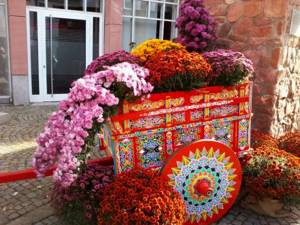
In the CCCP, cascading chrysanthemums were grown mainly in botanical gardens. In the 70s of the last century, six varieties of cascading chrysanthemums were tested in the collection of the Main Botanical Garden of the USSR Academy of Sciences: Contes de Secours, Ruisselliment d'Or, Cascade d'Orleans, Breeze Japones, Monet, Le Paravan Doré.
Compositions of cascading chrysanthemums are specially formed chrysanthemum bushes, the stems of which do not grow vertically upward, but hang down from pots or flowerpots at any angle intended by the author of this “work.” Contrary to the name, if they are not specifically formed on a special support, they will grow, as nature should, upward. Plants can also entwine frames of various shapes placed under them. In this way, you can create a variety of shaped compositions in the garden, decorated with bright chrysanthemum flowers.
Read also: Gamavit storage after opening
How to understand them
Probably, even experts cannot say how many varieties of chrysanthemums there are and how to distinguish them, much less classify them. But ordinary amateurs are even more unable to do this. Chinese flower growers grow about 3,000 varieties of chrysanthemums, and there are also other countries.
Every year the number of varieties increases, and it is not possible to distribute them by shape or size, and even taking into account the structure of the flower and the time of its flowering. And if we take into account the variety of chrysanthemum petals, the task becomes completely insoluble. And why?
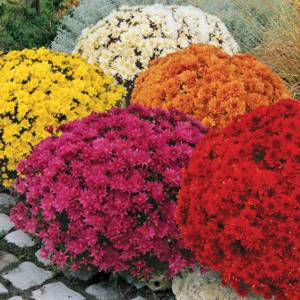
The perennial garden chrysanthemum, with all its diversity, is always recognizable by its unique aroma, leaf structure, flowering time, and care characteristics. We owe it to this flower that until late autumn we can admire the riot of colors in our garden, which is very valuable in our climate. The variety of species allows you to use flowers of different heights to decorate the space so that it sparkles with many colors.
Pinching and shaping garden chrysanthemums
Forming garden chrysanthemum bushes is easy and simple. You need to be able to form a bush correctly.
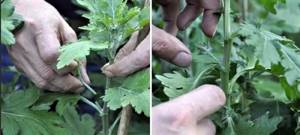
During this time, remove side shoots (stepchildren). This is especially important for large-flowered varieties.
Pinching a chrysanthemum
The first step is pinching or removing the top of the stem.
Due to this stage, plant growth is delayed. This then leads to better root development. And the formation of lateral shoots on the stem increases.
If the plant is left without pinching, it will quickly stop growing in height. And one flower bud will form at the top. And the side shoots, at the same time, have the wrong direction. The growth of lateral shoots is suppressed by the apical part.
The number of pinches may vary. It depends on the variety, cultivation technology and geographical location of the area.
It is recommended that gardeners do the first pinching 7-10 days after planting the seedlings in the ground. The height of the plants corresponds to 15-20 cm.
The second pinching is done 15-20 days after the first.
The last pinching should be done no later than two and a half or three months before flowering.
Depending on the number of pinchings and the timing of rooting, the diameter of the inflorescences changes.
Chrysanthemum pinching
To get large inflorescences, they do pinching. In this case, only one bud should be left on each stem.
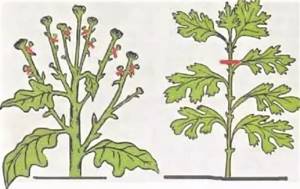
I remove (break out) all shoots developing from the axils of the leaves. Along with the shoots, the side buds are plucked out.
And again. the abundance of side shoots and buds reduces the supply of nutrients to the main shoot. Because of this, its development is delayed. That is, everything should be in moderation.
As soon as the side shoots can be grabbed with your fingers, they are immediately removed. The pinching starts from the top of the main bud.
Plants shoot regularly, as lateral buds and shoots appear.
Conditional classification
In order to somehow navigate the great variety of chrysanthemum species, you can use the simplest classification according to the main characteristics.
For example, if we take the size of the inflorescences as a basis and start from the border of 10 cm, then we distinguish between small-flowered chrysanthemums up to 10 cm and large-flowered chrysanthemums above this figure. This is the primary selection. Now we will analyze these two types into their components. Let's start with the small-flowered ones, which are presented as follows:
- small-flowered semi-double chrysanthemum - a distinctive feature is the flower located in the center, around which there are three-row petals;
- chrysanthemum small-flowered anemone-shaped - represents from one to several rows of petals;
- small-flowered pompom chrysanthemum - the name speaks for itself;
- small-flowered terry chrysanthemum - the splendor of the flowers catches the eye;
- single-row or double-row chrysanthemum - a small central flower is surrounded by rows of reeds.
The second criterion that allows you to distribute the types of chrysanthemums by height:
- border or low-growing chrysanthemums - do not exceed 30 cm, convenient for decorating garden paths;
- medium-sized chrysanthemums, reaching a height of up to half a meter;
- Chrysanthemums are tall, their growth starts from 1 m, among them are elite varieties.
Chrysanthemum varieties
There are many varieties of chrysanthemums. Therefore, each country has its own classification. The following classifications are considered the most successful: by flower size, by bush height, by inflorescence shape, by flowering time, perennials, annuals. Flower growers most often choose these varieties of chrysanthemums.
Chrysanthemum grandiflora
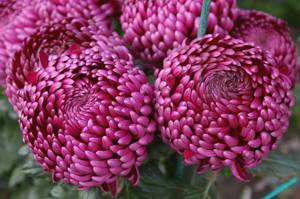
Large-flowered chrysanthemum: Anastasia Green variety, reaches a height of up to one meter, has inflorescences of an unusual green color.
Chrysanthemum parviflora
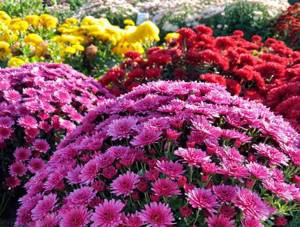
Small-flowered chrysanthemum: variety Slavyanochka, grows up to 80 cm, has pleasant, not very small flowers.
Chrysanthemum perennial
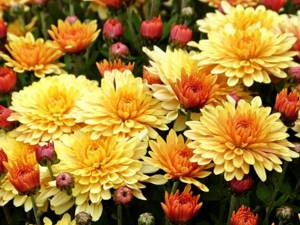
Perennial chrysanthemum: Flammenstahl variety with red flowers, brownish-yellow center. Intermediate chrysanthemums of the Debonair variety have different intense colors.
Bush babies
Let's move on to a detailed description of the presented varieties, starting with low-growing varieties of chrysanthemums. These babies, called perennial garden bush chrysanthemums, or also multifloras, are the first to open the flowering season.
They are very easy to recognize: up to 30 cm tall and a cap of inflorescences of various colors, located on top of dense bushes with leaves reminiscent of oak. They have many names: bush, border or spherical chrysanthemums.
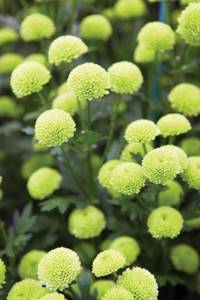
Middle-aged teenagers
Slightly higher in growth are chrysanthemum bushes, exceeding 30 cm and reaching half a meter. There is an endless variety of colors and shapes of flowers: anemone-shaped, pom-pom, double. They take up the flowering baton opened by the multiflora, starting to bloom in mid-August and ending towards the end of October.
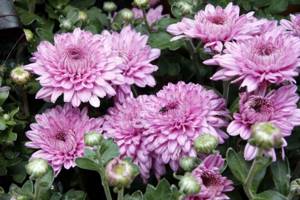
Most often, these chrysanthemums are presented by students on September 1 to their teachers.
Thanks to a strong root system, all types of medium-sized chrysanthemums quickly capture new territories, and if they are not thinned out, they will soon displace all nearby growing neighbors. Bouquets of these chrysanthemums become decorations for the home, unlike multiflora, whose purpose is to decorate the garden.
Chrysanthemum aristocrats
You will not confuse this species with any other: just look at the photo of tall garden chrysanthemums.
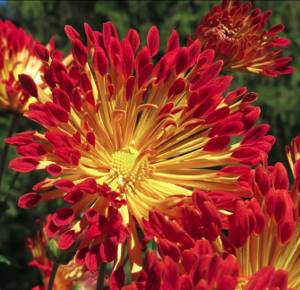
You can look at these flowers endlessly, rediscovering their beauty. They are most often grown in greenhouses, but in the southern regions they bloom beautifully in open ground. These beauties are frequent guests of exhibitions, where they amaze visitors with their bizarre inflorescences, and most importantly, their size.
As a rule, the size of the inflorescences significantly exceeds the size of the flowers of medium-sized and low-growing species, and this requires an appropriate thickness of the stem. Tall chrysanthemums begin to bloom later than others, but such beauty deserves to spend time waiting for it.
Classification by types and varieties
Chrysanthemum bush
Perennial chrysanthemum flowers surprise with their diversity; they are classified according to different parameters.
Cycle of life
- Annuals. Grown from seeds, require annual planting. The advantages are a long flowering period and resistance to cold temperatures.
- Perennial. Life cycle – more than 2 years. All perennial chrysanthemums are divided into two groups: Korean (the second name is border or low-growing) and greenhouse (the main purpose is cutting for bouquets, where they will look good). Korean representatives are distinguished by their unpretentiousness to adverse weather conditions.
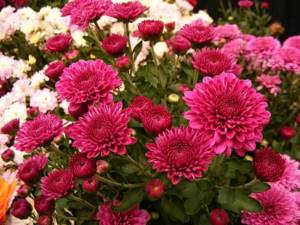
Chrysanthemum perennial
Flowering time
When do chrysanthemums bloom? It depends on what type they are:
- Early. They bloom in early autumn.
- Average. Flowering period is October.
- Late. They enter the phase of abundant flowering in November.
Cold resistance
Chrysanthemum species are divided into two groups, depending on their relationship to low temperatures:
- Cold-resistant. They easily tolerate the first frosts and are not afraid of light snow. Typical representatives of this group are Korean chrysanthemums.
- Heat-loving. They grow well in the southern regions; when grown in the northern regions, they do not have time to form flowers before the onset of frost.
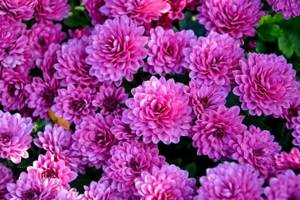
Cold-resistant chrysanthemum
By size and shape of inflorescences
This classification is the largest, since chrysanthemum flowers amaze with their diversity:
- Large-flowered. They are distinguished by a large diameter flower, up to 25 cm, of a hemispherical shape.
- Medium flowered. Flower diameter – up to 10 cm.
- Simple. They have a small flower with a core surrounded by petals arranged in rows.
- Terry. Some of the most beautiful representatives. They have many petals.
From these classifications it is clear that this sun flower amazes with its diversity. Each gardener can choose a variety for his garden that best suits his needs and climatic conditions, then it will be easier to care for it.
You can also choose flowers that look like chrysanthemums. These plants include daisies, lampranthus, helichrysum, gazania and bush perennial aster. This list can be continued; what you choose for your garden is a matter of taste.

Bush perennial aster
Reproduction of the "golden flower"
There are three ways to propagate chrysanthemums: by cuttings or division, and also by using seeds. The first two do not require excessive time investment. The seed option is most likely suitable only for breeders who would like to modify the original variety. In addition, this is a very labor-intensive and time-consuming process that may not give the expected result that you did not expect.
Therefore, it is still recommended to use either cuttings or division. That's where we'll stop.
Cutting method
Before you start implementing this method, look around your garden and be creative in its planning and arrangement: think about the color palette, about seasonal flowering, which should please you with its smooth transitions from spring flowers to late autumn ones. And now you, imagining the specific final look of your flower garden, can safely begin propagating chrysanthemums by cuttings or in another way.
Check out the step-by-step instructions.
If spring has already thoroughly come into its own and the air temperature has settled between 20 and 25 degrees, then it’s time to start the procedure:
- prepare temporary pots with suitable soil;
- prepare water at room temperature;
- inspect the existing chrysanthemum bushes, choose the healthiest of all, about 20 cm high;
- cut off the tops and tear off all the leaves from the cuttings;
- place it in the ground;
- water the cutting and leave it alone for 2 or 3 weeks;
- the pot with the cutting must be placed in a warm room with access to fresh air, not forgetting to monitor the condition of the soil, periodically moistening it;
- make sure that the cuttings have taken root and have taken root;
- plant them in open ground.
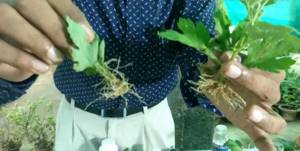
You see in the photo the planting of a perennial garden chrysanthemum and its care, and in the video you can watch the cutting process in detail.
Flower propagation methods
The largest bushes can be divided into several parts, resulting in 2-3 full-fledged plants, completely ready for immediate planting. In addition, propagation by cuttings is used, and the rarest (due to its labor-intensive) method is seed sowing.
Propagation by cuttings
To obtain cuttings, you can use a bouquet, as well as adult bushes. If a cut is used, the flower is removed and the shoot is placed in water. After 2-3 weeks, if successful, roots should appear. After this, they can be immediately planted in open ground.

Rooting chrysanthemum cuttings in planting boxes
Cuttings are taken from the bush in May. It is very important to use only healthy plants without signs of disease. The chopped shoots are buried to a depth of 5 cm on a loose bed, covered with a cut plastic bottle on top. After 2-3 weeks, new leaves should appear on the rooted cuttings.
Propagation by seeds
Sowing of seeds is carried out in February for seedlings. The germination period depends on the variety, ranging from 2 to 4-5 weeks. The seedlings are grown until May, and then immediately planted in the flowerbed. Some low-growing varieties can be grown in pots on windowsills, knowing how to plant a chrysanthemum and make it bloom.
It is difficult to collect seeds from bushes already growing in the garden in central Russia. Usually they do not have time to ripen before the onset of frost. But you can cut shoots with flowers almost close to the ground, place them in a vase with water and wait for the seeds to ripen at home.
Prevention of shredding of inflorescences
So, your chrysanthemums have been delighting you with their beauty for several years, but now you have begun to notice that the flowers of your beauty have begun to become smaller. This is a sign indicating that it is time to plant the chrysanthemum so that it begins to bloom with renewed vigor. Typically this procedure is performed every 4 years.
Let's begin the description of the process of transplanting chrysanthemums with a reminder that this is done in the spring, when the weather is warm:
- clean and sharpen a garden knife;
- prepare a manganese solution of moderate concentration;
- It is better to use a fork for digging, so you will not damage the roots;
- Having dug up the bush, remove excess soil;
- Using a prepared knife, carefully separate about 5 shoots from the main bush;
- immerse the shoots in containers with manganese for about 2 hours;
- plant new bushes in prepared open ground.
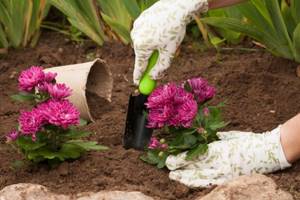
And expect your chrysanthemums to bloom in late summer.
You see in the photo the planting of a perennial garden chrysanthemum and its care after division and rooting.
Cascading chrysanthemums: cultivation
Growing cascading (ampel) chrysanthemums begins with cuttings of the varieties chosen to create the composition. Several rooted cuttings, reaching a length of 10-15 cm, are planted in containers. After the seedlings take root in a new place and grow to 20 cm in length, they are pinched, removing the tops of the shoots. After 3-4 weeks, when side shoots grow on the plants, their tops are plucked off again, leaving only the two or three longest stems intact.
Shoots from the upper axillary leaves grow faster than the lower ones, so they are not pinched at the same time: the upper ones are five to six days earlier than the lower ones. Pinching of shoots is completed 2.5 months before flowering.
Chrysanthemums whose last pinching was at the beginning of August bloom at the end of October, and if it was done at the end of August, flowering accordingly moves to November.
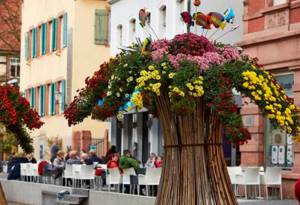
Cascade of chrysanthemums on a Parisian street
After the second pinching, a 25 cm long peg is carefully dug into the base of the plant. A slat about 50 cm high is dug in next to the pot. A third slat is attached between the peg and the slat at an angle of 45 °C, to which the chrysanthemum shoots are tied.
During the season, the plants are watered abundantly, fed, side shoots are periodically pinched, and closer to the beginning of flowering, the stems are carefully detached from the slat. By this time, the plants will be sufficiently strong and will keep the shape that was given to them using the slatted structure. To form bushes, you can also use special figured frames.
Otherwise, caring for hanging chrysanthemums is no different from caring for their ordinary “relatives”.
Parade of beauties
There is an opinion that chrysanthemums are very unpretentious and undemanding to care. This is true only for short and medium-sized flowers. These types of perennial chrysanthemums will thank you for timely watering and mulching of the soil, as well as a suitable place in your garden where there is enough sun. And they are not afraid of the cold and early frosts of our latitudes.
But this has absolutely nothing to do with tall, elite varieties of chrysanthemums. They are very picky about temperatures, soil, fertilizer, watering, and even nearby growing neighbors. It must be said that these picky creatures feel best in the southern regions of our country or in greenhouses.
If you have not lost your enthusiasm and want to see a “golden flower” in your garden, then choose a place for it at a relative elevation and with daily access to sunlight for about 6 hours.
Below are photos of varieties of garden chrysanthemums, which give an idea of the beauty and diversity of these flowers.
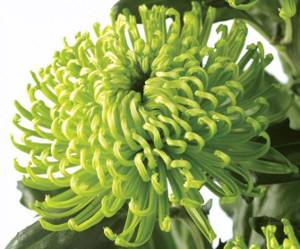
The Champagne Spray variety is a tall chrysanthemum. When growing, it needs support. The color of this chrysanthemum matches its name, as does the shape of the petals.
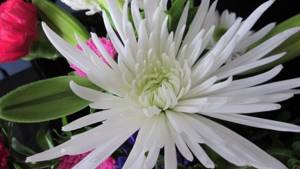
This snow white is called Evelyn Bush, also a tall beauty, whose decoration is a flower 12 cm in diameter.
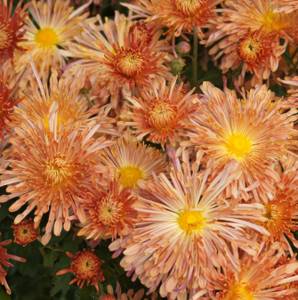
This cheerful orange-brown color is characteristic of the Zorka variety, which is classified as medium-growing. Caring for this variety is not too complicated and is accessible to any gardener.
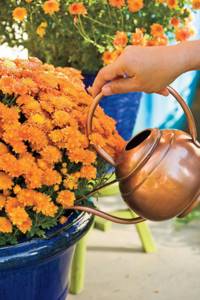
And these beauties come from Korea, but feel great in our latitudes. Among them there are both short and medium height. All of them do not require close daily attention: it is enough to periodically seat them. The rest is standard care.
So, you have read the photos of perennial varieties of garden chrysanthemums and have a primary idea of the types and differences in care. All that remains is to make a choice and begin taming the “golden flower”.
Chrysanthemum flowers. Description, features, types and care of chrysanthemums
When there is a desire to decorate your garden with unpretentious, but royally magnificent flowers, not just plants, but those that are in tune with your mood, lyrical and melancholy, or, on the contrary, mischievous and playful, flowers about which there are many legends and which have a myriad of history real stories - then the choice is obvious. These flowers are chrysanthemums .
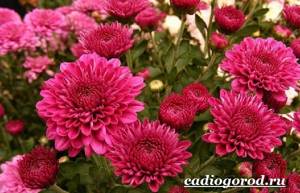
Description and features of chrysanthemums
There are so many varieties of these flowers that the chrysanthemums in the photo create a completely different idea of themselves. However, all of them, both miniature and giant, both perennial and one-season, both indoors and gardens, belong to the family Asteraceae, although some types of botany are perceived as controversial and try to rank them either among the genera of tansy or in the Aster family, then in general to the relatives of the yarrow.
Mostly in gardens you can find chrysanthemum shrubs; very rarely, gardeners plant herbaceous varieties in plots. The height of the bushes can be different, from 45 cm to two meters. The leaves of chrysanthemums , like those of rose flowers , are completely different - they can be:
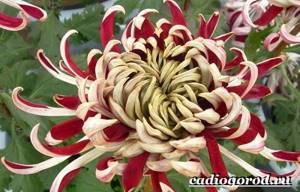
- simple and “complex”;
- solid elongated;
- jagged;
- dissected;
- notched;
- smooth and pubescent.
The inflorescences of plants are equally diverse. Most of the decorative varieties decorating gardens come from China, where the first written mention of fresh chrysanthemum flowers appeared in 551 BC, when describing the filling of another imperial garden.
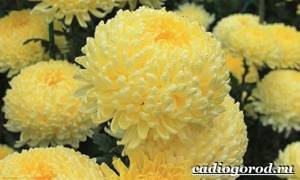
Planting and propagation of chrysanthemums
Chrysanthemums can be propagated either by cuttings or dividing the bush, or by seeds. Cuttings are cut in late spring, when the temperature is consistently above 16 degrees.
The length of each cutting must be at least 7-10 cm; they take root in nutritious soft soil within 2-3 weeks. After this, they can be immediately planted in open ground, in a permanent place.
Dividing the bushes is done in early spring, before the buds begin to ripen, but when the soil has thawed. Usually, in the middle zone it is the end of April or the beginning of May.
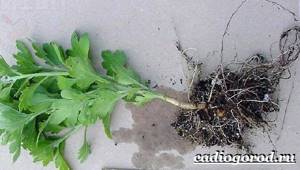
As for the seeds, you can either grow seedlings from them or sow them directly in the chosen place for the flower garden. Sowing is carried out at the end of May, after all frosts. The distance between the holes should be at least 20-30 cm. The planting site should be covered with film for faster seed germination.
The first feeding of bushes sprouted from seeds should be done on the 8-11th day of their life; ready-made complex fertilizers for the varietal group that was planted are ideal for this. If annual varieties are sown. Such chrysanthemums will bloom in August, and they will have to be fed at least twice more.
However, as a rule, most gardeners purchase seedling bushes for planting. Indeed, this is in many ways more convenient, has a number of advantages and is much easier to plant.
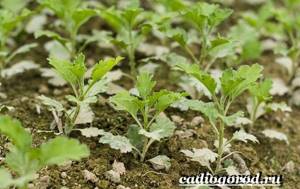
Bush chrysanthemum seedlings are planted at the end or mid-May, after all frosts have ended. A place for the future queen of the garden should be chosen that is windless, well lit and without possible stagnation of water in the soil.
As for the soil itself, the plant prefers slightly acidic loams; it is on them that the bush will provide owners with the most luxurious bouquets of chrysanthemums .
Before planting, you need to apply a complex organic fertilizer to the bottom of the hole that meets the needs of the selected variety. According to the observations of flower growers, those plants that were planted in cloudy or rainy weather take root and grow much better and faster.

Caring for chrysanthemums
in caring for chrysanthemums , and it applies to absolutely all such flowers, both street ones and those growing on window sills.
It consists in the fact that it is necessary to pinch the upper buds on the shoots, this provokes branching, and as a result, the plant forms a round, amazingly decorative fluffy bush, strewn with flowers.
As for watering, a chrysanthemum flower in a pot , so it is advisable to check the moisture level at the depth of the pot, this is easy to do - you need to pierce the ground with a wooden stick and leave it for a few minutes, then carefully pull it out and see how the wood is damp.
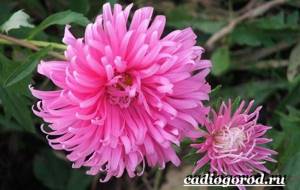
In the garden, the bushes need to be watered abundantly, but do not allow moisture to stagnate in the soil, as it provokes rotting of the roots. There is no need to spray the plant; chrysanthemums of all types, in principle, do not like water on their leaves.
Regarding fertilizers, you should follow the alternation of mineral and organic complexes and apply them one by one; you need to feed the bushes 4 times a season. And during the formation of buds, you need to add a phosphorus-potassium complex for garden chrysanthemums.
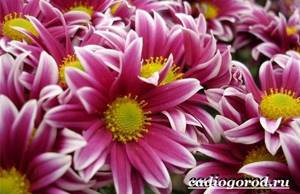
Types and varieties of chrysanthemums
Among the many varieties of these flowers, there are also favorite varieties that occupy a strong place in the hearts of flower growers and those who simply love beautiful, long-standing cut chrysanthemum flowers . For those who want to admire white chrysanthemums , the following types will be of interest:
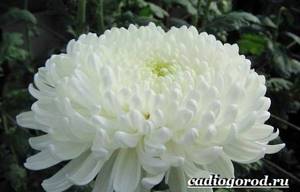
- Gazelle
These are “caps”, very large, from 13.5 cm in diameter, double white flowers. Flowering begins in mid-August.
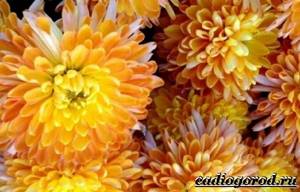
- Alec Bedser
They resemble dahlias, semi-double, white with a cream tint, large, from 12 to 15 cm in diameter, flowers with a yellow or green core. Flowering begins in early August.
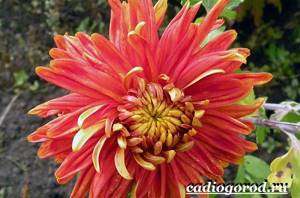
- Deliana
These are everyone’s favorite sharp-petaled needle-shaped flowers up to 18 cm in diameter, with a pronounced center. Flowering begins at the end of July.
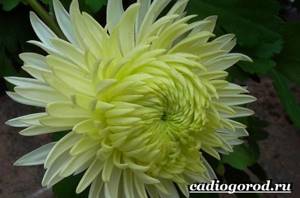
- Anastasia
Huge round needle-shaped balls, reaching up to 20 cm in diameter. It blooms late, from the end of September.

- Pearl
Everyone's favorite type of chrysanthemum, many small snow-white pearl balls on one branch. It stands well without water and does not lose its decorative qualities when dried. Flowering begins in August and lasts until the end of November.
No less popular are varieties of chrysanthemums with yellow flowers , the most popular in gardens:
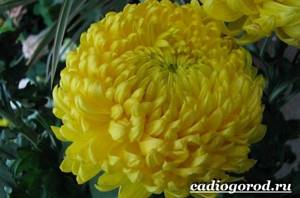
- Rivalry
Huge, rich yellow, sunny-colored spherical “caps” of flowers up to 20 cm in diameter and double flowering, which begins at the end of August and ends in November.
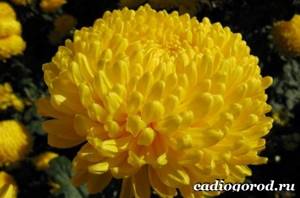
- Orange
It has all the qualities of the Rivalry variety, but it blooms already in July and ends flowering in September-October.
- Zembla Yol
Exotic among chrysanthemums. Round sunny balls of double flowers with a diameter of 10 to 16 cm bloom in September and continue to bloom until the bush is covered with snow.
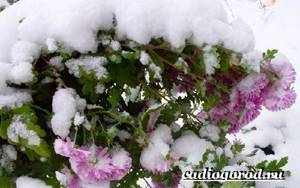
There are also many beautiful multi-colored species, hybrid varieties with variegated colors and elegant beauties reminiscent of large daisies.
As an indoor flower, chrysanthemum can grow regardless of the variety; you just need to take into account the size of the bush and choose a clay pot of suitable size.
Diseases and pests
Bushes of both and annual chrysanthemums
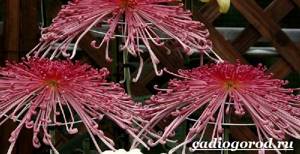
Fungal infectious diseases:
- powdery mildew;
- gray rot;
- leaf rust;
- verticillium wilt.
Effective in the fight against fungal infections:
- Bordeaux mixture;
- copper emulsion;
- soap solutions;
- colloidal sulfur.
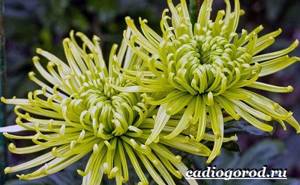
chrysanthemum flowers grown from develop viral diseases that are fatal to them in the first year of life:
- mottled mosaic leaves;
- aspermic lesions of buds and leaves;
- dwarfism, that is, a noticeable delay in growth against the background of premature flowering.
Of the garden parasitic elements, the following are drawn to chrysanthemums:
- aphids of all varieties;
- garden bugs;
- slugs and snails.
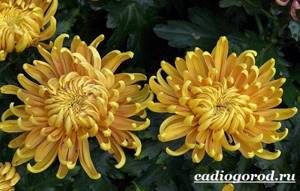
It is best to combat them with the help of ready-made chemicals sold in specialized stores. Despite the instability to diseases, any gardener needs to buy chrysanthemum flowers and plant them in his garden, because no other plant, not even roses. It cannot boast of such splendor, diversity, rich history and many meanings attached to the flower as the chrysanthemum .





